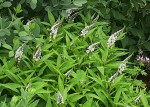 Native to moist soils of China and Japan, this clump-forming herbaceous perennial is a member of the primrose family, Primulaceae, that also includes cyclamen. It grows up to 3′ tall from a rhizomatious root system and has medium green leaves that are ovate-lanceolate, 3-6″ long, and turn orange-red in the fall. In late spring, gooseneck-shaped racemes 12-18″ long appear bearing densely packed tiny, star-shaped white flowers 1/2″ wide. The plants are very vigorous in moist soil and may be somewhat invasive but are easily pulled out. They look best grouped in an informal setting such as cottage or wet meadow gardens. The genus name, Lysimachia, honors King Lysimachus (661-281 B.C.), Macedonian King of Thrace. The specific epithet, clethroides, is from the Greek klēthra, the name for alder, and refers to the remblance of the plants to those in the genus Clethra.
Native to moist soils of China and Japan, this clump-forming herbaceous perennial is a member of the primrose family, Primulaceae, that also includes cyclamen. It grows up to 3′ tall from a rhizomatious root system and has medium green leaves that are ovate-lanceolate, 3-6″ long, and turn orange-red in the fall. In late spring, gooseneck-shaped racemes 12-18″ long appear bearing densely packed tiny, star-shaped white flowers 1/2″ wide. The plants are very vigorous in moist soil and may be somewhat invasive but are easily pulled out. They look best grouped in an informal setting such as cottage or wet meadow gardens. The genus name, Lysimachia, honors King Lysimachus (661-281 B.C.), Macedonian King of Thrace. The specific epithet, clethroides, is from the Greek klēthra, the name for alder, and refers to the remblance of the plants to those in the genus Clethra.
Type: Herbaceous perennial
Bloom: Small white flowers on gooseneck-shaped spike from late spring to early summer
Size: 3’ H x 3” W
Light: Full sun to partial shade
Soil: Humusy, consistently moist, well-drained
Hardiness: Zones 3-9
Care: Deadhead to prolong bloom; control spread
Pests and Diseases: None of importance
Propagation: Division in spring or fall
Companion plants: Gayfeather (Liatris spp.),Siberian iris, daylily, beebalm

I was curious if you thought this particular plant would be a good ground cover for a barren area in my yard that I’m trying to make into an outdoor entertainment area. It would be divided from the chimnea, benches, and adirondacks by a small granite stone culvert (runoff from a gutter). Also there are five white oaks that make the border of this area, and I have about a 50 plant, monkey grass border surrounding the area. Will the Gooseneck try and get throught the monkey grass? Will it attack tree roots? I’ve heard awful things about it, but I like the tales of its resilience. Thanks for any advice you can give.
KGC
KGC,
The goosenect loosestrife spreads by underground rhizomes and would probably get into the monkey grass. I doubt it would hurt the trees in anyway. Although it spreads quickly it is very easy to pull out (but difficult to eliminate entirely.) Also, if the conditions are not ideal it will not be as vigorous as if conditions are less than ideal.
Karen
Karen,
I just planted Gooseneck this spring for the first time. (A friend gave it to me with warning) I love it. How do I prepare it for the winter? Do I cut it back and mulch? I live in upstate NY on Lake Ontario.
Melody,
I cut mine back and forget about it until spring but I live in a warmer climate. It is hardy to zone 3 but if you have to mulch other plants like phlox, I would mulch this too.
Karen